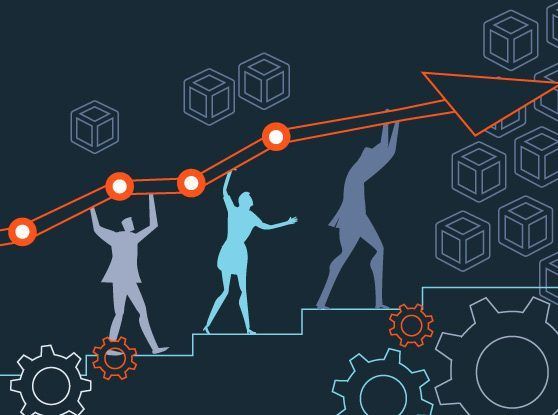
ABM & The New Marketing Landscape: Q&A with 6sense’s CMO

In our post on The New Marketing Landscape we emphasized the importance of rethinking your marketing strategy in a world of COVID-19. This is a world of financial uncertainty for your prospects and customers, resulting in decreased budgets, longer sales cycles, and higher churn. It’s also a world of competing priorities. Key influencers and decision makers are drowning in priority issues, making it challenging for marketers to earn their attention.
ABM enables companies to dynamically prioritize target accounts to identify those that are in-market and ready to buy
Given these new realities, Account Based Marketing (ABM) is top of mind for marketing leaders since ABM is about more efficient and effective demand gen through meaningful engagement at priority accounts. Using intent data, ABM enables companies to dynamically prioritize target accounts to identify those that are in-market and ready to buy. This helps marketing, sales, and customer success focus their resources more efficiently. ABM is also known to increase satisfaction, retention, and expansion within existing accounts – which will be critical for companies in the days ahead.
While there is a lot of interest in ABM, there are also a lot of questions around the impact of a remote workforce on core ABM tactics. For example, how effective are tools and tactics that rely on workplace IP addresses when everyone is working remotely? This includes intent data, account-based ads, and website and chat personalization. Similarly, what happens to direct mail when no one is in the office?
To answer these questions, we turned to Latane Conant, CMO at 6sense. She can speak to how 6sense handles these questions from a technical perspective, as well as speak to ABM best practices and how the 6sense team is making ABM work for them in this new world.
A core part of ABM is identity resolution and using that for intent data. Identify resolution means knowing who the anonymous website browser is, and knowing who is researching key topics across the web. IP addresses play a role in that process. What happens in a world where everyone is remote and no longer at their corporate IP address? Does intent data still work?
It really depends on the software vendor’s capabilities and how they match IP addresses. We always strongly urge companies to do a match test with potential ABM providers, so they can ensure they’re getting the best intent possible.
From a 6sense perspective, we have a patented Company Graph that uses a combination of IP addresses, device IDs, and cookies to match anonymous buying signals to accounts. This is whether buying signals are on a customer's own website or across 6sense’s intent network, and whether those accounts are known to a customer (already exist in CRM or MAP) or not.
For anyone who's currently working from home but connected to their VPN, the 6sense Company Graph picks up the corporate network and all activity is associated with the company as normal. As we start to see devices move from corporate IPs to home IPs, this actually strengthens our Company Graph, as it enables us to map new home IPs to companies.
So, even with current circumstances, we believe our platform is still the best solution to match anonymous intent/buying signals to accounts and target digital ads.
What does this mean for website personalization and account-based ads?
Whether you’re personalizing experiences on your website, a content hub, or via other channels like email, ads, or direct mail, it’s critical that you have accurate account data. There’s nothing worse than personalizing an experience based on bad account information, as it can do more harm than good. And because accurate account matching is so important, you have to be very stringent about the process for associating new IPs, device IDs, and cookies with accounts in our Company Graph.
Once a home IP has been associated with a company, it can be used for targeted display ads via 6sense, and we can also trigger personalized web or content experiences for that person once they visit your website from that home location. If we were unable to match the visitor to an account, they would be served the default visitor experience.
While 6sense’s Company Graph significantly outperforms every other account identification technology in the market, no solution is perfect. 6sense’s Company Graph matches approximately 85% of all anonymous activity to accounts, and this level of matching enables our customers to accurately personalize experiences and serve ads to more target accounts than any other solution.
Looking at tactics, direct mail is a staple of ABM. How does this tactic change now that people are no longer in the office?
Knowing the right addresses for people is always a challenge. That’s why we like working with companies like Sendoso and Alyce that offer address verification to confirm recipient addresses and allow recipients to securely provide the information as part of the sending process.
Digital sends/E-stores are also a great way to provide a personalized experience. Recipients can choose a gift from a well curated group of options. For scaling ABM programs, this is a great option; you have a digital marketplace that can manage storage, fulfillment, and tracking — and can be tied back to larger programmatic campaigns.
Given the circumstances, think about how relevant the gift is. What does someone especially need right now? For example, gift cards for food delivery, grocery shopping, subscriptions for Netflix, Disney+, Audible, and so on.
Selling with empathy is important right now and there’s no better time than the present to pivot standard gift offerings and focus on giving back to charities that could most use our support like American Red Cross, Meals on Wheels, and Feed America.
Are there other tactics that need to be modified or new tactics that should be considered?
Based on my (virtual) conversations with other CMOs across the country, the main things they are pivoting focus to are Account-Based Marketing, sales enablement, and thought leadership/content. Here’s what we’re doing and recommending to really shine in those areas:
- Orchestrate ABM. The key to standing out right now with ABM is to orchestrate great experiences, with killer creative, personalized ads, content hubs, virtual meetups, chat functionality, and more. Everyone is shifting spend to digital right now, so consider all touchpoints you can use. Also consider how this can be applied to all aspects of the funnel – top, middle, and customers.
- Enable sales with the best insights possible. Sales enablement is tricky right now and it’s easy for sellers to become paralyzed by the current situation. Deep insights that tell you who to target, why to target them, and what they care about are more important than ever. Legacy mechanisms for account targeting won’t be as effective if they can’t show you what buying stage people are in. Companies with access to sophisticated ways to understand anonymous and known buying activity to detect InMarket accounts are well-positioned to enable their teams.
- Be a thought leader in your market. Thought leadership is critical right now, as times are uncertain and people are looking to you for guidance. Chances are your marketing team is regularly creating new content as part of your current strategy. The key is ensuring it gets in front of buyers at the right time, in a consumable fashion. We’re evaluating our existing content and overall strategy to ensure our content is personalized, adds value, and creates an engaging journey.
- Focus, focus, focus on customers. Sounds cliche, but it’s more important than ever that we focus on customer experience right now. Rather than rush to launch 15 new campaigns, we’re thinking about how to add the most value to our customers in this unprecedented time. You have to ask yourself, “How can we do something to significantly help customers, beyond sending a “we have contingency plan and are still operational email?” We’re offering 6sense customers unlimited account targeting and for a specific period of time, adding best practice webinars and virtual user groups to ensure they can make the most of this added capacity.
- Open the (virtual) gates! I've been on the “free your content” bandwagon for a while now. I feel it’s even more important right now because people are stuck at home, but still want to learn. Smart marketers want to be the brand that engages and enables their customers and prospects. It’s scary because eliminating (or reducing) form fills may change your MQL game, but you can shift your top-of-funnel measurement to review and inspect account engagement with the ultimate goal of getting InMarket accounts.
- Let your field marketers shine. Our field marketing team is quickly becoming experts in virtual webinar solutions, spinning up personalized content hubs, and launching account-based display campaigns. Their job is still to align with sales and engage top accounts — it’s what they’re amazing at. But now is a great time for the role to advance into holistic account-based experts.
What advice can you give companies on how to approach their ABM programs given the current environment?
I learned in marriage counseling not to give advice. So rather than advice, I’ll offer a shared experience. I’m practicing what I call “pragmatic positivity” and executing the following plays:
- Examining content and creative. True story: We ran a campaign called “Do The Match” a few months ago. The landing page and creative were honestly kinda lame, and the results were pretty lame too. For Valentine's Day, we re-did the campaign with the same CTA, but this time made it fun and interesting with killer creative — and it’s done amazing in terms of ideal customer engagement and new pipeline. We just re-did it again for St. Patrick's day.
- Doubling down on our current display strategy which accounts for buying stage and keyword. Essentially, as buyers move through their journey we adjust the message accordingly. We also ensure the message aligns to the keyword we know they are most interested in — so if it's ABM, they get the ABM journey; if it's predictive analytics, they get a journey with content aligned around predictive analytics.
- The show must go on… just in a different and more targeted way. Rather than wait at the booth and hope our targets meet us, we’ve taken the list and used predictive analytics to determine the best accounts for us and are running special virtual events personalized for the accounts and persona. Often, big tradeshows cover a wide range of sales and marketing professionals, this approach allows us to be very dialed-in with the right content for key personas. Speaking of events, I’m super PICKY about them. Our events need to be high-end experiences. It’s challenging with digital, but we’re trying to get creative. For example, when we moved our CMO breakfast series to digital, we sent registrants an UberEats gift card, so they could actually have breakfast with us.
It’s about selling with empathy, but still selling. I’ve seen some chatter on LinkedIn about not prospecting right now. My stance is, we’re a business with something valuable to offer. I’m proud of our product and it’s our job to continue to educate buyers about what we do and how we can help them. Our approach has always been to focus on value, and that will continue regardless. We’ve made some slight tweaks to ensure we’re on-point and sensitive, but on the whole, I believe GTM leaders must work even harder to keep morale high for our customers, the market, and our team.











